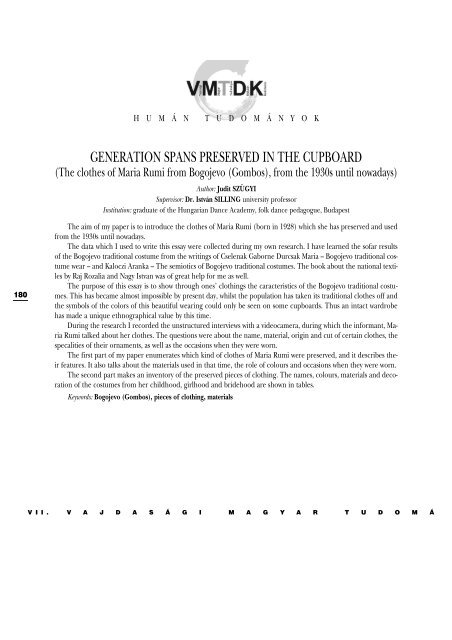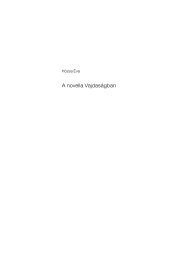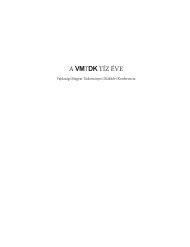Rezümékötet 2008. - vmtdk
Rezümékötet 2008. - vmtdk
Rezümékötet 2008. - vmtdk
Create successful ePaper yourself
Turn your PDF publications into a flip-book with our unique Google optimized e-Paper software.
180<br />
H U M Á N T U D O M Á N Y O K<br />
GENERATION SPANS PRESERVED IN THE CUPBOARD<br />
(The clothes of Maria Rumi from Bogojevo (Gombos), from the 1930s until nowadays)<br />
Author: Judit SZÜGYI<br />
Supervisor: Dr. István SILLING university professor<br />
Institution: graduate of the Hungarian Dance Academy, folk dance pedagogue, Budapest<br />
The aim of my paper is to introduce the clothes of Maria Rumi (born in 1928) which she has preserved and used<br />
from the 1930s until nowadays.<br />
The data which I used to write this essay were collected during my own research. I have learned the sofar results<br />
of the Bogojevo traditional costume from the writings of Cselenak Gaborne Durcsak Maria – Bogojevo traditional costume<br />
wear – and Kaloczi Aranka – The semiotics of Bogojevo traditional costumes. The book about the national textiles<br />
by Raj Rozalia and Nagy Istvan was of great help for me as well.<br />
The purpose of this essay is to show through ones’ clothings the caracteristics of the Bogojevo traditional costumes.<br />
This has became almost impossible by present day, whilst the population has taken its traditional clothes off and<br />
the symbols of the colors of this beautiful wearing could only be seen on some cupboards. Thus an intact wardrobe<br />
has made a unique ethnographical value by this time.<br />
During the research I recorded the unstructured interviews with a videocamera, during which the informant, Maria<br />
Rumi talked about her clothes. The questions were about the name, material, origin and cut of certain clothes, the<br />
specalities of their ornaments, as well as the occasions when they were worn.<br />
The first part of my paper enumerates which kind of clothes of Maria Rumi were preserved, and it describes their<br />
features. It also talks about the materials used in that time, the role of colours and occasions when they were worn.<br />
The second part makes an inventory of the preserved pieces of clothing. The names, colours, materials and decoration<br />
of the costumes from her childhood, girlhood and bridehood are shown in tables.<br />
Keywords: Bogojevo (Gombos), pieces of clothing, materials<br />
V I I . V A J D A S Á G I M A G Y A R T U D O M Á




